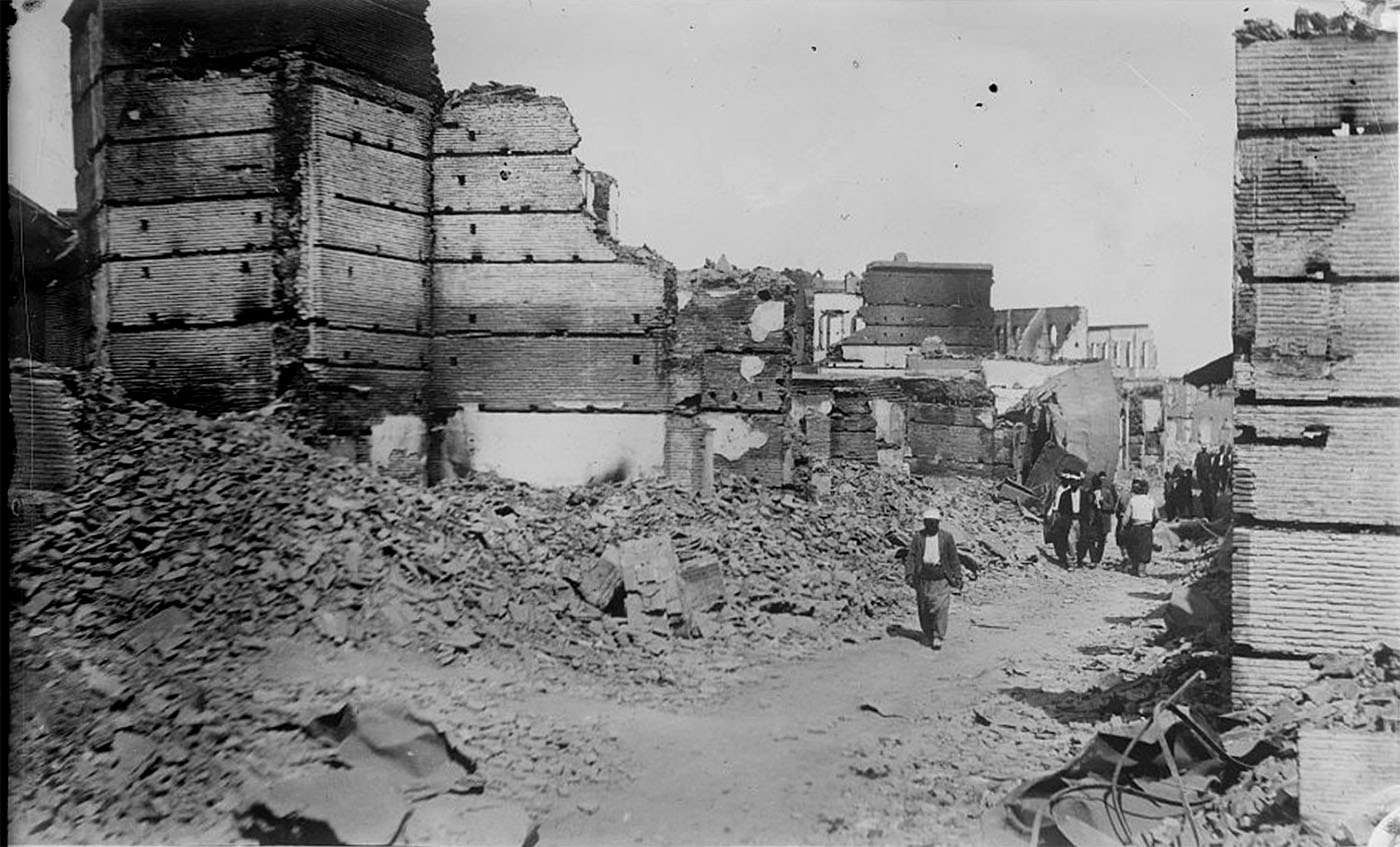In his book, Bedross Der Matossian provides a more precise account of the Adana massacre than the official Turkish and Armenian narratives. He also identifies the events and dynamics that lead to acts of violence to further understand how and why ordinary people commit them.
The Horrors of Adana, by Bedross Der Matossian
Stanford University Press, 2022
ISBN 9781503631021
Sean Casey
In the early twentieth century, the province of Adana was an economically vibrant and culturally diverse province of the Ottoman Empire on the Mediterranean coast, center of cotton production and home to populations of Muslims and Christians — Turks and Kurds, Armenians and Greeks. Over the course of two weeks in April 1909, massacres in Adana killed over 20,000 Armenians. What became known as the Adana massacres were covered at the time in the international press, but have since been absent from many of the period’s histories.

In The Horrors of Adana, historian Bedross Der Matossian provides a sustained examination of these momentous weeks in a deeply researched work of microhistory. Following historian Jacques Semelin’s contention that massacres resist the explanatory power of a single discipline, Der Matossian takes a multidisciplinary approach, infusing history with psychology and anthropology to portray both events and the emotional disposition of the events’ actors. While the historical focus of The Horrors of Adana is narrow, Der Matossian’s work nonetheless achieves a remarkable breadth, marshalling an international and multilingual array of primary sources to limn the atrocities from the vantages of Ottoman and Armenian histories as well as international journalism. His contention, throughout, is that violence does not inhere in a particular culture or religion; rather, in what becomes the book’s refrain, “given the appropriate conditions and political stresses, ordinary men can turn into brutal murderers.”
From the outset, Der Matossian establishes his intent to provide a fuller, more precise account than the official narratives that live on in Turkish and Armenian histories. Where Armenian histories contend that the Ottoman central government orchestrated the massacres as a “dress rehearsal” for the Armenian Genocide of 1915, Turkish histories advance the fiction that an Armenian rebellion to reestablish the medieval Armenian Kingdom of Cilicia caused the violence. As a corrective, Der Matossian offers a layered explanation of varied actors and dynamics. In response to the Armenian historical narrative, Der Matossian notes the decentralized orchestration of the Adana massacre, underscores the diverse composition and motives of its perpetrators, and depicts Armenians not as “passive objects” but “active subjects in their own history.” To counter the Turkish narrative of Armenian rebellion, Der Matossian patiently identifies and delineates the myriad events and dynamics that culminated in mob violence.
Der Matossian’s account of the Massacres pinpoints the Young Turk Revolution of 1908 as a pivotal disruption. Shaking the established order of the Ottoman Empire under the autocratic Sultan Abdülhamid II, the Revolution restored constitutional government and opened public spheres that enabled Armenian participation. Armenians resuscitated previously illegal political parties, established newspapers, and led political processions. Wary of reactionary, anti-Armenian forces, Armenians also purchased arms. Meanwhile, Ottoman Muslims in Adana affiliated with the previous regime viewed Armenian political assertiveness and weapon acquisition as a threat; they used the open public sphere to propagate rumors that Armenians plotted to revolt, massacre Muslims, and reestablish the Armenian Kingdom of Cilicia. These rumors, or what we would now call disinformation, intensified ethnic tensions. The counterrevolution of April 13, 1909, then precipitated the violence.
Massacres are deliberate, rational, identifiable acts of violence, and to further understand how and why ordinary people commit them is key to their prevention.
The Adana massacres transpired in two waves separated by eight days, with mob violence beginning in the city of Adana and spreading through Adana province and the neighboring province of Aleppo. The massacres killed Armenians in the greatest number and destroyed businesses and farms. While other Christian minorities were targeted, including Chaldeans and Greeks, Der Matossian points out that religion was not the massacres’ primary motive and that not all Christian populations were targeted. He emphasizes the varied motives of the massacre’s various actors:
While the Armenians engaged in the conflict with a motto of self-defense, the motives of the Muslim population were much more complex. Circassians, Afghans, Cretan Muslim refugees, Turkmens, Turks, and seasonal laborers were motivated by a host of factors, ranging from looting and plundering to diminishing Armenian economic power in the region and waging a genuine war against the “Armenian threat” of massacring the Muslims, among other motives.
By attending to the massacre’s multiplicity of actors and motives, Der Matossian creates an account of the Adana massacres that cannot be collapsed into a compact, convenient narrative. What’s more, in providing a fuller account of Adana, Der Matossian begins to inventory the necessary conditions for massacres more broadly — highlighting, for instance, recent scholarship on the power of rumor to instigate ethnic violence.
Some of the most powerful passages in The Horrors of Adana emerge from the extensive international press coverage. The Hebrew language press out of Palestine, for instance, noted strong similarities between Armenians in Adana and Jews in Russia. Reporting for the French newspaper Le Matin, Antonio Scarfoglio compared the ruins of Adana to the 1908 Messina earthquake in Sicily which destroyed the cities of Messina and Reggio:
It is the horror of Messina and Reggio … an entire city lying in the fields, killed with a stroke of the sword of destiny, suffocated in 15 seconds, the same horror of gutted, raped houses, which show naked shreds of privacy … streets cluttered with debris, sewing machines, old watches, women’s hats, ribbons, letters. The same horror and the same, terrible landscape. Here the same silence, the same impression of the collective, complete, final death of an entire city; this mathematical certainty that nothing more lives, that nothing more will be renewed, that everything, everything is dead, except the memory, but even more horrible perhaps than in Messina!
Scarfolio’s searing and kinetic prose depicts a landscape of complete, manmade ruin; it anticipates, in the totality of destruction it details, the genocide of the Armenians which, less than a decade away from the Adana massacres, looms over Scarfolio’s words and these pages.
The Horrors of Adana inevitably addresses the relationship between the Adana massacres and the Armenian Genocide of 1915 in which 1.5 million Armenians were killed. Der Matossian does not subscribe to what he terms the “continuum approach” of the Armenian Genocide, where “previous phases of violence,” such as the Adana Massacres, are viewed as early stages of the same genocide. He takes pains to distinguish the Adana massacres from the Armenian Genocide and disrupt facile attempts at linking the two. He emphasizes how, unlike the Adana massacres, local in organization and diverse in motivation, the Armenian Genocide was centrally planned by the Ottoman government, guided by a unified ideology. However, Der Matossian does hold that the lack of accountability following the Adana massacres did set the stage for future violence. Following the Adana massacres, the Ottoman courts-martial administered a pantomime of justice, punishing minor actors and letting main perpetrators, such as the “inner clique” of Young Turks, go without punishment. “The failure to punish the true perpetrators of the massacres,” Der Matossian writes at the end of a closing chapter, “emboldened the inner clique … to commit a larger crime against the Armenians: the Armenian Genocide.”
Der Matossian ends his remarkable study of the Adana massacres by pulling the camera back from microhistorical detail to examine massacres more broadly. To understand how “ordinary men and women from many different religious and cultural backgrounds are capable of barbaric crimes,” Der Matossian places the Adana massacres alongside two other massacres: the Odessa Pogrom of 1905 and India’s Sikh massacres of 1984. Through these comparisons, he notes a striking “global parallelism in the structures of massacres”: in the Odessa pogrom and Adana massacres, for instance, a “dominant group targeted a nondominant group that was seen as an existential threat.” In all three massacres, rumors were a crucial catalyst of mob violence. The book’s macrohistorical coda on the underlying structures of massacres is brief, serving as an invitation for future scholarship, but it explains why, despite Der Matossian’s tight focus on a two-week period in 1909, The Horrors of Adana hums with contemporary resonance.
Massacres are deliberate, rational, identifiable acts of violence, and to further understand how and why ordinary people commit them is key to their prevention.




